Wednesday 30 October 2024
Two Incursions a Millennium Apart into Leicester by the Marquis Family
LAHS Member Steve Marquis explores his own connection to the 10th Century Viking occupation of Leicester.
I suspect this rather convoluted title would seem somewhat incredulous to readers of this blog but also, hopefully, a little intriguing. Behind this title is a remarkable story that links my family to the legendary Viking, Ivar ‘the Boneless’, the Norse/Gaelic MacDonalds and the 940CE occupation of Leicester by the Viking Olaf Guthfrithson in one of those surprising coincidences of history.
Let’s start with Olaf (also known as ‘Anlaf’) Guthfrithson the Viking king who occupied Leicester in 940CE and according to the 13th century chronicler, Roger of Wendover, met with the Anglo-Saxon King Edmund (brother of the recently deceased King Athelstan) to agree on dividing the country along similar lines to those that had created the original Danelaw only 56 years previously. Whether this meeting followed some kind of clash outside Leicester cannot be confirmed as the available evidence is contradictory. However, the agreement clearly favoured the Vikings and Michael Wood believes there is at least the possibility of a significant battle somewhere close by which was either inconclusive or an English defeat: -
“So why were Edmund and his councillors prepared to surrender the East Midlands which had been so hard won by Edward, Æthelflaed and Æthelstan? Perhaps Edmund had come off worst in the battle at Leicester; perhaps the losses of frontline troops at Brunanburh only three years before were so great that Edmund simply had to buy time. Perhaps too the fear of more bloodshed was real: it was common in early medieval warfare to avoid fighting if at all possible; better to try to make peace and even to pay the Vikings off.” Wood
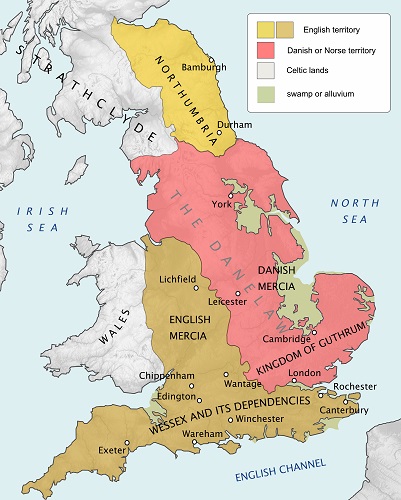
Olaf or Anlaf Guthfrithson became king of Dublin (which also included other parts of Ireland and the Isle of Man) York (Jorvik) and Northumbria on the death of his father, Gofraid ua Ímair (younger brother of Ragnall ua Ímair, a key figure in this story, see below) in 934. Three years later Guthfrithson suffered a catastrophic defeat alongside Constantine II, King of Scotland, Owain, King of Strathclyde, and other Viking kings by the English King Athelstan at the Battle of Brunanburh (recently the subject of a film called The Last Kingdom: Seven Kings Must Die).
Olaf Guthfrithson was clearly the most powerful leader in the British Isles after Athelstan. It was said that his fleet contained 165 ships, an extraordinary number for the period, and even if exaggerated, he still led an enormous invasion force. Brunanburh was the largest and deadliest battle of the Viking era, with horrendous losses on both sides. Although forced to return to Dublin with his tail between his legs, Guthfrithson was soon back after taking advantage of the confusion caused by the untimely death of Athelstan only two years later in 939, and re-invaded England to regain Viking control over Jorvik and Northumbria.
He then moved south into the Danish Five Boroughs and occupied Leicester which he used as a base to ravage and plunder large parts of Mercia, including capturing the fortified burh of Tamworth, the old Mercian capital:
“Anlaf took the burh by storm, taking great booty and noble prisoners including the Mercian royal lady Wulfrun.”
This is a very interesting story in itself which some members might wish to follow up.
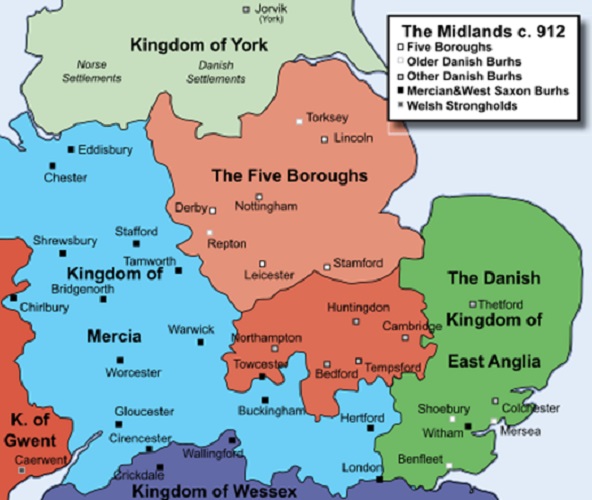
According to the 12th century chronicler, Roger of Howden, in his Historia Regum,
“Anlaf took as his wife Aldgyth the daughter of Jarl Urm by whose advice and help he had gained the aforesaid victory.”
Documents show that Jarl Urm or Orm attended Athelstan’s court on several occasions and that he even accompanied him on his 934 invasion of Scotland. This would suggest that Jarl Orm (‘Orm’ meaning the serpent – or even the dragon) was the dominant figure not only in Leicester but throughout the whole of the Five Boroughs. However, Guthfrithson’s victory would be short-lived, he was dead within a year and his heirs that tried to hold onto the Kingdoms of Jorvik and Northumbria were driven out by Edmund in 944.
For more on Guthfrithson’s occupation of Leicester checkout Michael Wood’s 1987 Orm the Serpent: A Tale of Viking Leicestershire, in L.A.H.S Transactions, Volume 87. The above quotes come from this article.
It is almost certain that some of my ancestors would have accompanied Guthfrithson, an incredible claim I know but one that can be substantiated. But first, who was Olaf Guthfrithson?
Ímar/Ivar ‘the Boneless’
Olaf Guthfrithson was the great-grandson of Ímar, founder of the Viking Uí Ímair dynasty that would rule over the Western Isles, west coast of Scotland (this area was called Innse-Gall – ‘Islands of the Foreigners’ in Gaelic – by the defeated Gaels) as well as Dublin, several other entrepôts in Ireland and the Isle of Man, for the best part of four hundred years, in addition to the Danelaw during the ninth and tenth centuries. The Dane Ímar, described as the King of Dublin between 870-873 had been the predominant figure in the region since 853, where along with Norse Olaf ‘the White’, he united Danish and Norwegian Vikings, consolidating Scandinavian rule over Innse-Gall and the Irish Sea region. In the Norse Sagas ‘Ímar’ becomes Ivar ‘the Boneless’ son of Ragnar Lodbrok, the central characters in the recent TV series Vikings. Ivar ‘the Boneless’ not only subjugated Innse-Gall and the Irish Sea, he was also the foremost leader of the ‘Great Heathen Army’ in the first major Viking invasion of England that captured York and then invaded East Anglia in 869, slaughtering its king, Edmund ‘the Martyr’, who was entombed in what would become the Abbey of Bury St Edmunds. In 874, the ‘Great Heathen Army’ occupied Leicestershire, although, Ivar seems to have died just before this occurred and was perhaps buried at Repton, Derbyshire.¹ Most experts in this field do now believe ‘Ímar’ was indeed Ivar ‘the Boneless’.²
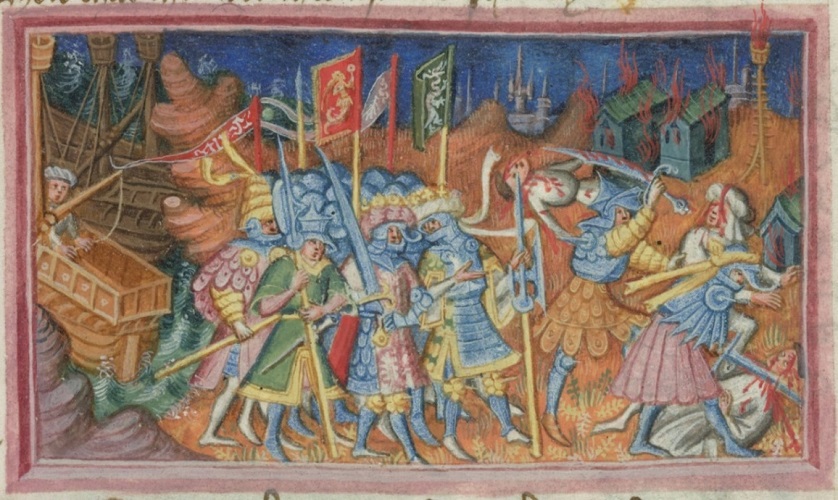
Dublin, essentially the capital of the Scandinavian ruled Irish Sea region, was created by the Vikings as one of the main centres of the European slave trade. In 902, the native Irish managed to expel the Vikings, but twelve years later Olaf’s uncle, Ragnall ua Ímair, King of Dublin, Waterford, Jorvik and Northumbria led the group of Norwegian and Danish warriors that arrived off the coast of Ireland in 914. Accompanied by his brother, Sitric Cáech, they restored Viking rule over Dublin and the surrounding area along with Waterford. After this victory, Ragnall ua Ímair left Sitric in charge of Dublin whilst he went on to reoccupy Jorvik and Northumbria in 918 (recently lost to King Edward and his sister Æthelflaed, ‘Lady of the Mercians’) and restored his kingship there until his death in 921. He was succeeded by his brother Sitric Cáech, who reigned until his own death in 927. Olaf’s father, Gofraid ua Ímair, (younger brother of Ragnall) followed as king of Jorvik and Northumbria until 934 when Olaf, already king of Dublin, succeeded him and took over the leadership of Viking resistance to the expansionist ambitions of Athelstan, that ultimately led to Brunanburh.
But how are the Marquises connected to Olaf Guthfrithson?
The origins of the Marquises like the MacDonalds and many other Highland Gaelic clans go back to the 9th century Scandinavian invaders led by Ivar ‘the Boneless’ (founder of the Uí Ímair dynasty), who went on to marry local women from the existing Gaelic elites and gradually evolved into a Norse/Gaelic ruling class. The leading families of both the Marquises and MacDonalds are the direct descendants of the early Viking rulers of Innse-Gall and Scandinavian controlled parts of Ireland.
Viking rule over Innse-Gall lasted until the Battle of Largs in 1263 when Scottish King Alexander III defeated Haakon Haakonsson, King of Norway. The power vacuum left by the end of Scandinavian sovereignty was filled by the rise of the Gaelic Highland clans, in particular Clan Donald who would eventually govern the region as the ‘Lords of the Isles’.
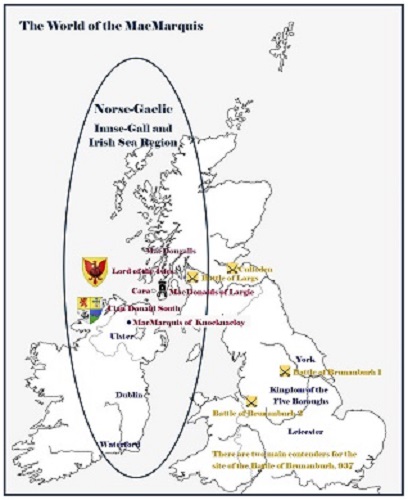
Donald Mor McRagnall (died 1250), the progenitor of Clan Donald was directly related to the Uí Ímair dynasty through Somerled (Somhairle) a direct descendent of Ivar ‘the Boneless’. Described as the King of Argyll and the Isles, and clearly the dominant ruler over Innse-Gall during the mid-12th century, Somerled was one of the most important figures in Scottish history, although his legacy was largely achieved by his sons and grandsons who would go on to form Clan Donald, Clan Dougall, Clan MacRory, Clan MacSweeney and possibly Clan MacAlister (see family tree 2 below), the principal clans of the Gaelic Western Isles and Highlands (A’Gàidhealtachd – Land of the Gaels).
The Marquis family derive their name (in Gaelic Mhic Mharki, see below) from Echmarcach mac Ragnall (died 1064 or 65) who was the x4great-grandson of Ragnall ua Ímair, Viking King of Dublin, Waterford, Jorvik, and Northumbria and therefore also a direct descendant of Ivar ‘the Boneless’. He is recorded as having attended a meeting in 1031 with King Cnut of England and Denmark, King Malcolm of Scotland and MacBeth of Moray (later, in 1040, King MacBeth of Shakespearian fame), so clearly, Echmarcach was acknowledged as the principal ruler of Viking Ireland during that period.
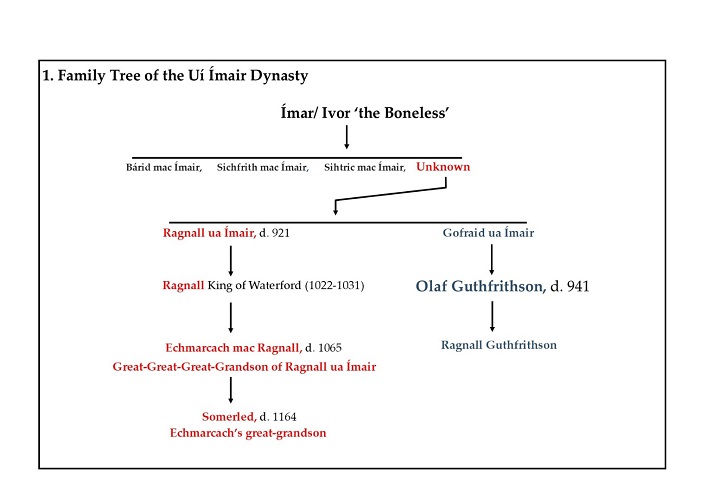
The Marquises became part of Clan Donald through Marcus (Marcach) MacDonald who was killed in Ulster in 1397 (Mhic Mharki means ‘son of Marcus’).
“Marcus MacDonald in the Annals of the Four Masters is referred to as "Marcach", which is obviously a hypochoristicon (a pet name or diminutive form of a name) of Echmarcach [see above] which confirms my hypothesis about your [the Marquis] family origins.” Dennis Freeman-Wright.³
Marcus Macdonald was the grandson of Alasdair (Alexander) Óg MacDonald who became the third Clan Chief (cinn-cinnidh) of the MacDonalds in 1293 and was, therefore, a direct descendant of Somerled. After Alasdair’s death in 1299 fighting the MacDougalls on behalf of King Edward I of England he was succeeded by his brother Angus Óg (meaning youngest son), whose own son, John of Islay, later became the first Lord of the Isles. Alasdair Óg’s family moved to Ulster after losing the inheritance battle with Angus Óg, where some of his six sons established one of the most important MacDonald (MacDonnells in Ireland) galloglass bands: Norse/Gaelic mercenaries fighting in the endless conflicts between the leading Irish clans and increasingly against Anglo-Norman invaders. Several of Alasdair Óg’s sons were killed leading their galloglass fighters in the Irish O’Connor’s civil war, including Somhairle (obviously named after the original Somerled) the youngest. In fact, all of Somhairle’s own four sons were also killed. Marcus MacDonald, the youngest, was killed in 1397 at the Battle of Lissadell along with his eldest son, Dugall. Marcus MacDonald’s heirs would go on to form one of the most important of the MacDonald galloglass septs (sub-clans) in Ireland. These galloglass mercenaries would dominate warfare in Ireland until the end of the 16th century.
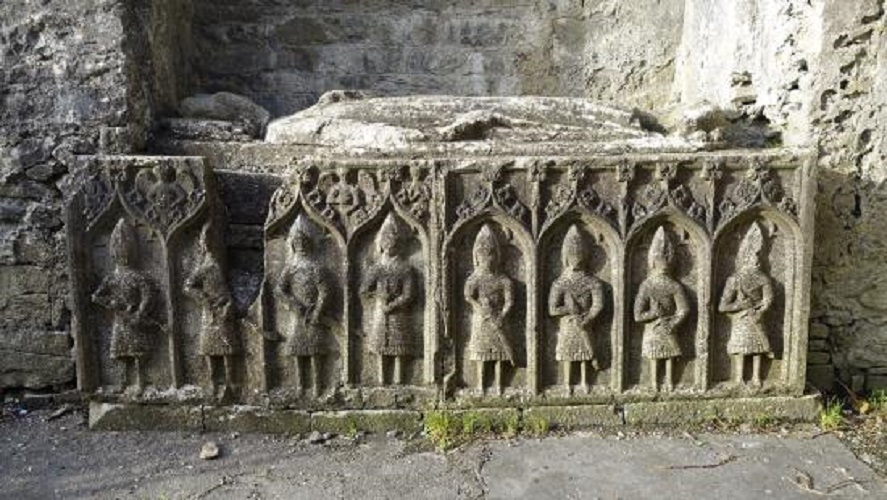
It was from Marcus MacDonald that my family name became firmly established within the Clan Donald hierarchy. Mhic Mharki was later latinised to ‘MacMarcuis’ before being anglicised to ‘Marquis’ around 1800. The Mhic Mharki, now MacMarcuis, still had an important presence in Ulster as galloglass fighters as late as the end of the 16th century. In 1568, Donnell McMarques, “whose statement made to the English authorities in Carrickfergus, concerning the possibility of the Campbells and MacDonalds entering the war in Ireland, was passed on to Elizabeth I.” Twenty years later there is also a reference to a poem honouring the chief of the MacMarcuis galloglass of ‘Knocknacloy’ (Knockloughrim today). It is dated to 1588, but we do not have the name of its author nor the first name of that chief.
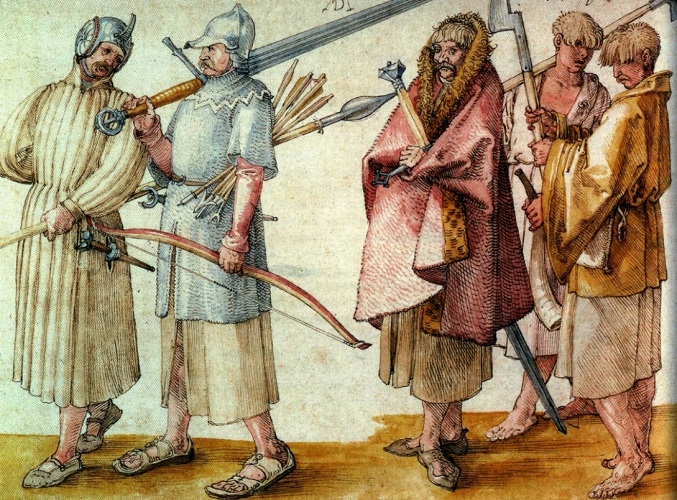
My own branch of the Mhic Mharki (by this time called MacMarcuis) had by the turn of the 15th century returned to Argyll and became the hereditary bardic family to another Clan Donald sept, the MacDonalds of Largie on the Mull of Kintyre. A relationship that was first recorded in 1506 but almost certainly goes back much further and would last for another three hundred years. At their pinnacle during the heyday of the Lordship of the Isles they were a significant bardic family and substantial landholders with lands to the north and south of Campbeltown. This centuries-old, shared relationship not only involved bardic services but also clan conflicts, a civil war, Jacobite rebellions and a whisky smuggling enterprise on the island of Cara. Over the centuries, they would follow their MacDonald patrons down the road of decline and almost self-destruction – the consequence of invariably choosing losing sides and fighting losing battles.
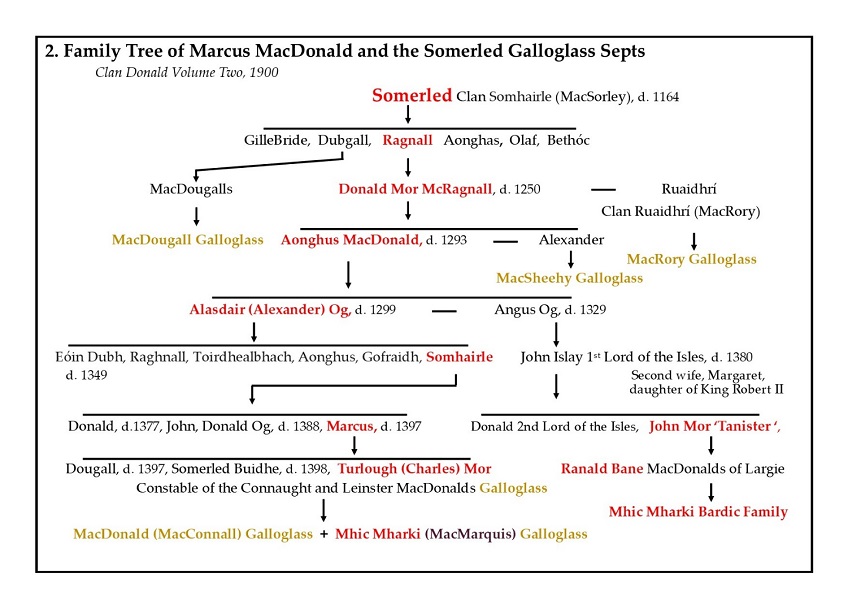
Ragnall ua Ímair and Echmarcach mac Ragnall were clearly members of the Uí Ímair dynasty as was Olaf Guthfrithson, the great-grandson of Ivar ‘the Boneless’. Another important member of the Uí Ímair dynasty was Somerled (Somhairle) whose sons and grandsons created many of the Gaelic Highland clans. Marcus MacDonald was x5great-grandson of Somerled and therefore the direct descendant of Ivar ‘the Boneless’ which means that the Mhic Mharki through both their family ties to Marcus MacDonald and Echmarcach mac Ragnall were also part of the Uí Ímair dynasty. It is clear from the evidence that the Mhic Marki were an integral part the Norse/Gaelic ruling elites of Innse-Gall and Ireland, and would therefore have joined Olaf Guthfrithson in his campaigns in England and consequently his occupation of Leicester. A DNA test showed I have Scandinavian, Scots/Irish and English traits as would be expected.
An interesting family history but not one to be especially proud of. My earliest ancestors were essentially land-grabbing, power-seeking murderers, and yet, they were also survivors in the extremely violent, bloody and unforgiving history of Scotland and Ireland.
Nearly a thousand years later, the most recent incursion of the Marquis family into Leicestershire occurred in 1925 when my grandparents, Angus Marquis and Mary Jordan (a domestic servant from the age of 14 in Glasgow), arrived in Leicester as economic migrants from Scotland. Angus had been born in 1901 into a fishing family in Tarbert, Kintyre, (a direct descendent of the Mhic Mharki bards), but the harsh life on a fishing boat didn’t appeal so he moved to Glasgow and became an engineering apprentice aged 14 in the Govan shipyards. Mary’s father, Ernest H. Jordan, had been born in Groby, Leicestershire, and after serving in a Scottish regiment for many years and then recovering from a serious wound received during the Boer War, returned to his previous occupation as a quarry worker. He moved to the Bonawe Quarry near Oban, Argyll, in 1905. This family connection with Groby was presumably why my grandparents moved to Leicester from Glasgow completely unaware of the circumstances of the previous Marquis visit to the county.
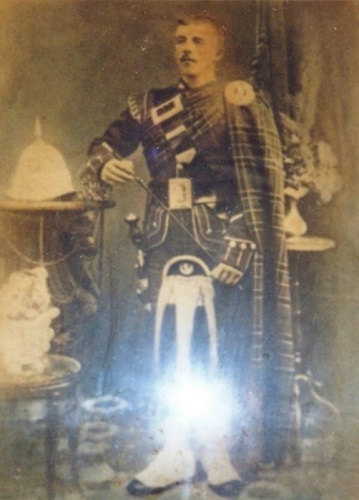
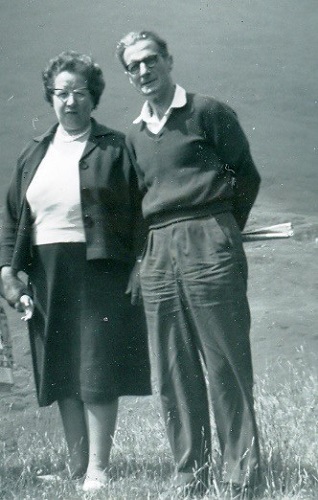
Steve Marquis 2024. Email: stephen.marquis@ntlworld.com
Notes
1. In 1686, a Viking burial mound was discovered in Derbyshire close to the battle site where the Great Heathen Army defeated the Mercian king Burgred. The dating of the mound and its clear high status make it the possible last resting place of Ivar ‘the Boneless’.
2. Although there is still some debate over whether Ímar was indeed Ivar ‘the Boneless’, the consensus opinion now accepts that they were the same person. Even if this was not the case, it would in no way negate the veracity of the story told here. For more information on this, checkout my family history website
3. “My word but you have an interesting family tree.” These were the opening words in an email Dennis Freeman-Wright sent me after meeting him for the first time at the last L.A.H.S’s history fair at Beaumanor Hall where we got into a conversation about the origins of the Marquis family and their links to Clan Donald. Dennis is a keen etymologist and has studied in great detail the history of the MacDonalds.
4. The Marquis Family of Argyll by Steve Marquis (2018) provides further detail on the family tree from Marcus Macdonald to the present day. A longer article on the origins of the Marquis family and links to the Vikings is also available here. At the time of writing this blog, an article on the shared history of the Marquis and Macdonalds has also been submitted to the Macdonald High Council in Skye where it has received recommendation to be added to their library.
A fifteenth-century depiction of Ívarr and Ubba ravaging the English countryside as it appears on folio in the British Library. Wikimedia Commons ( Public Domain) https://commons.wikimedia.org/wiki/File:Harley_MS_2278,_folio_48r_excerpt.jpg


